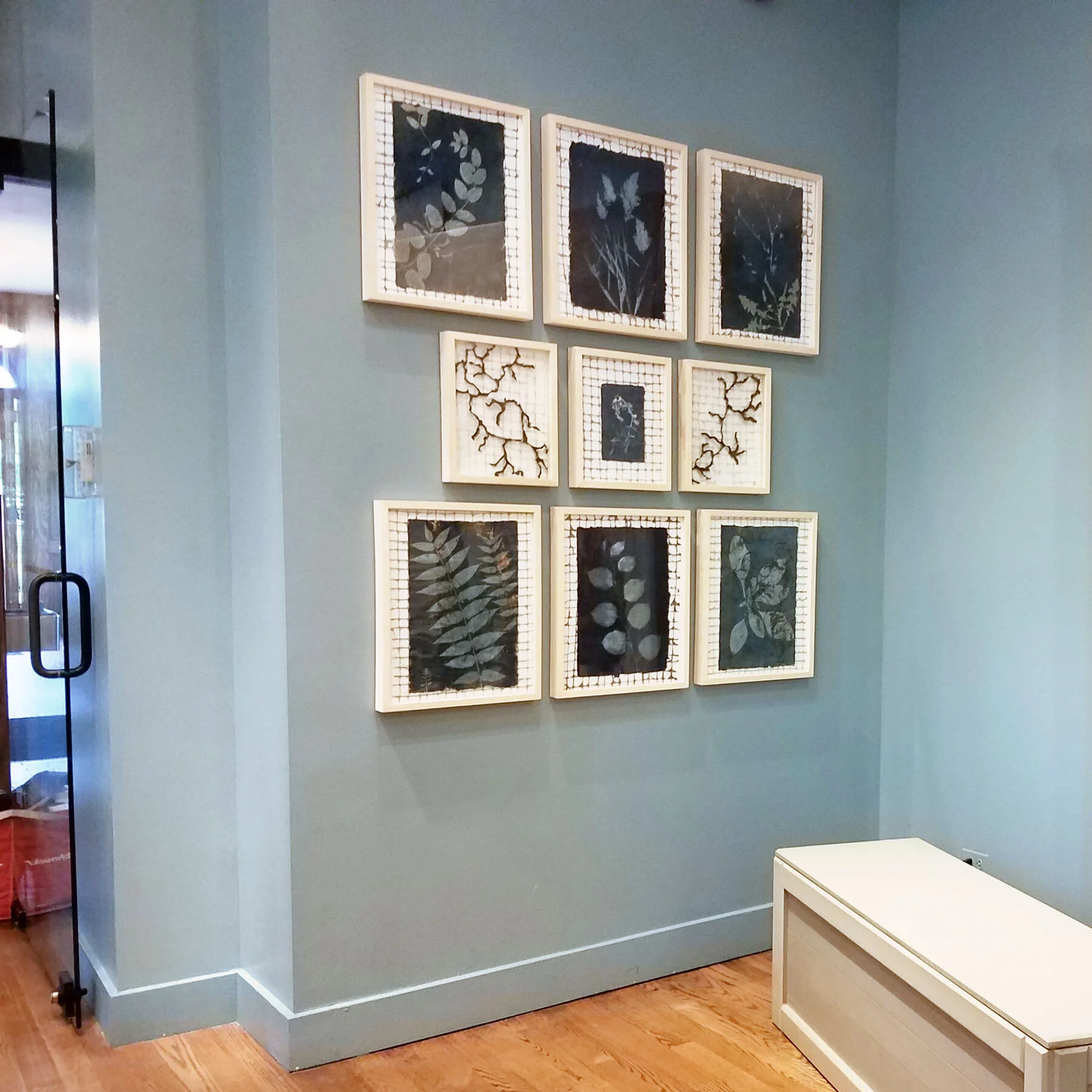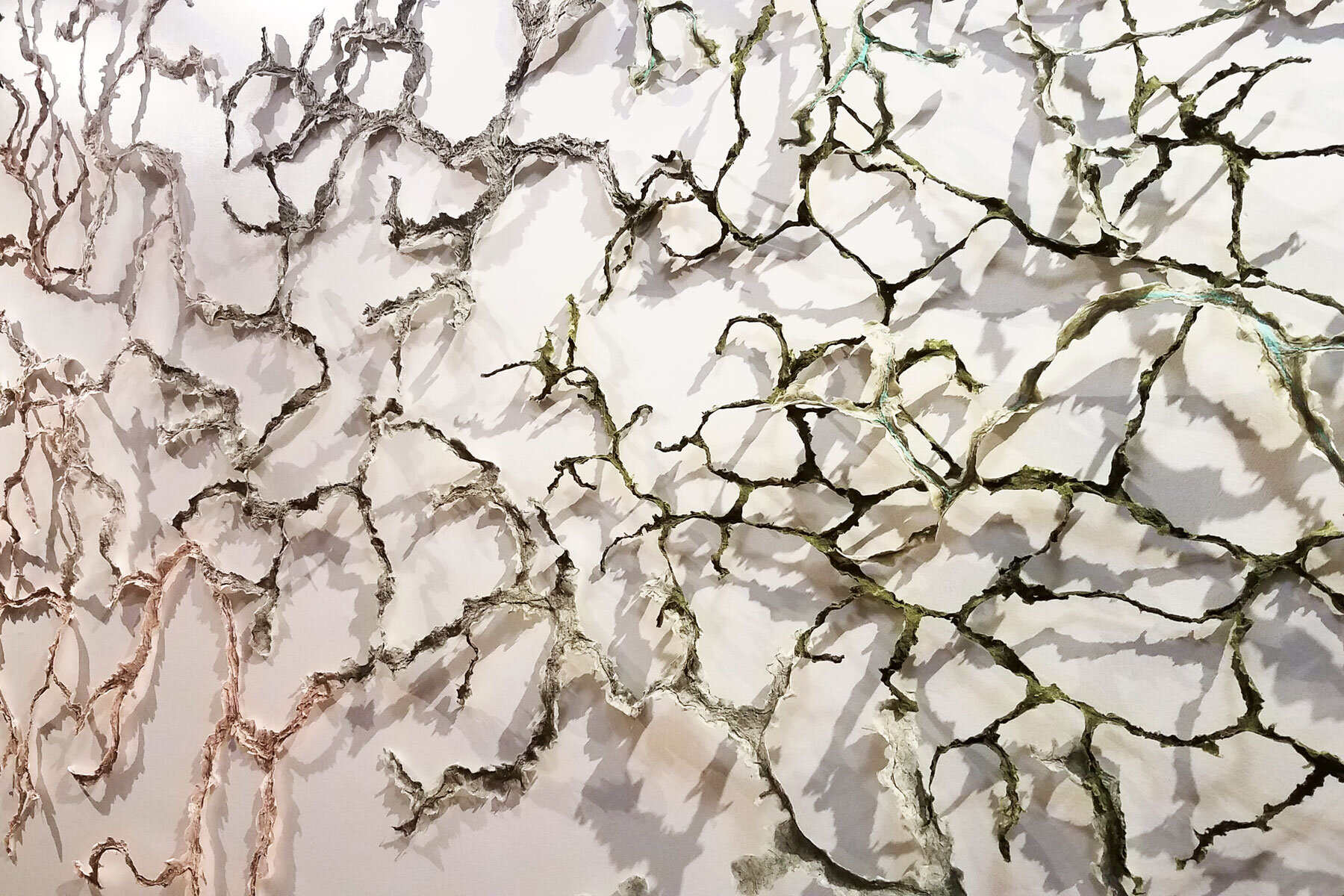Ebb and Flow
A series of installations created collaboratively and individually by Megan Singleton and May Babcock. Ebb and Flow is based on research into dendritic waterways and plants found in local landscapes. The geomorphology and plant ecologies of the area are the inspiration for the installation of handmade paper, in not only how it shapes space, but also in the imagery and paper pulp used. As both site-specific and place-based installations, unique iterations of Ebb and Flow have been installed in both gallery and public spaces across the country.
Ebb and Flow I
Based on watershed maps of the Missouri, Mississippi, and Blackstone Rivers, and incorporating Mississippi River Mud and American Lotus.
Ebb and Flow I, Megan Singleton and May Babcock, Handmade Paper Pulp from Mississippi River Mud, Abaca, Cotton, American Lotus, 25 ft x 12ft, 2016.
Installed at the Springfield Art Association M.G. Nelson Family Gallery, Springfield, IL.
Ebb and Flow II
Inspired by the waterways and flora of Narragansett Bay. Dendritic patterns found in watershed maps and plant forms are interpreted using problematic plants that have been collected locally and transformed into handmade paper pulp.
The installation includes the taxonomy and vector drawings of the vegetation. The laser cut drawings are made from the paper fiber corresponding to the plant each depicts.
Ebb and Flow II, Megan Singleton and May Babcock, Handmade Paper Pulp from Abaca, Cotton, Japanese Knotweed, Phragmites australis, Eurasian water-milfoil, Variable Milfoil, Inflated Bladderwort, Codium fragile, Heterosiphonia japonica, laser-cut handmade paper, 20ft x 14ft, 2018.
Installed at the Granoff Center for the Creative Arts, Brown Arts Initiative (BAI) Annual Mural, Brown University, Providence, RI
Support Save the Bay: Narragansett Bay, whose mission is to protect and improve Narragansett Bay and whose vision is a fully swimmable, fishable, healthy Narragansett Bay, accessible to all.
Ebb and Flow V
A response to the nearby Blackstone River watershed area, its industrial textile history, plant ecologies, and current status. I began by researching the areas history and visiting 7 different dam sites along the river where I sketched, photographed, and collected shoreline sediment and shoreline and aquatic plant species. I used harvested plant fibers, sediment, and linen rag for pulp to create dendritic lines of dimensional paper. Directly related to Ebb and Flow V is a group of 24 circular handmade papers, Blackstone River Suite, which acts as a type of taxonomy of the installation and sites. Cyanotype prints with text and imagery identify dam sites, fibers, and plant species, while river mud papers and pulp paintings are explorations of the material.
Ebb and Flow V, May Babcock, Handmade paper from linen rag, abaca, variable milfoil, common reed, Japanese knotweed, pigments, river sediment, 40’ x 14’ x 6”, 2018.
Exhibited at Machines with Magnets Gallery in Pawtucket, RI.
Support the Blackstone River Watershed Council, whose mission is to “restore, enhance and preserve the physical, historical and cultural integrity of the Blackstone River, its watershed and its eco-system, through public advocacy, education, recreation, stewardship and the promotion of our unique Blackstone Valley resource.”
Ebb and Flow VI
Based on the Des Plaines watershed map and ecologically problematic plant species in Lockport Illinois, 30 miles southwest of Chicago, Ebb and Flow VI explores the local landscape through the medium of papermaking—at once a historical handcraft and industrial technology. The sculptural lines of dark green paper pulp depict the shape of the Des Plaines Watershed.
This site specific installation is accompanied by cyanotype contact prints of problematic plants impacting the ecology of the watershed. Cyanotype is a historical photographic process that was developed in 1842 by Sir John Herschel in England. In 1853, Anna Atkins, famed as the first woman photographer, utilized the cyanotype process to study and record plants. She published the first book in history to use a photographic process to convey scientific botanical information. We chose this process to convey the parallel developments in engineering and technology happening across the globe during the time period of the construction of the Gaylord Building, I&M Canal, and city planning of Lockport.
Ebb and Flow VI, May Babcock and Megan Singleton, Artist-made paper from abaca, common reed, variable milfoil, 9ft × 11ft, 2018
Ebb and Flow VI (After Anna), May Babcock and Megan Singleton, Cyanotype on artist-made paper from cotton, abaca, variable milfoil, common reed, Japanese knotweed, various sizes, 2018. Group of framed works from top left: Japanese Honeysuckle, Common Reed, Chicory, Variable Milfoil, Eurasian Milfoil, Variable Milfoil, Tree of Heaven, Japanese Knotweed, Common Mullein.
On permanent display at the Gaylord Building, National Register of Historic Places, Lockport, IL.
Part of unLOCK: Merging Art & Industry
Consider supporting the Gaylord Building, a National Register of Historic Places site, and The International Association for Great Lakes Research (IAGLR), a scientific organization made up of researchers studying the Laurentian Great Lakes, other large lakes of the world, and their watersheds, as well as those with an interest in such research. The Ebb and Flow installation series was featuring in an IAGLR publication.
Ebb and Flow VII
Part of the exhibition, ReSeeding the City and an attendant community forum, created to expose and explore a range of responses to the often contending forces of people and plants in the urban setting. Ebb and Flow VII is made from handmade paper crafted of local waste plant fibers, expressing the changing nature of Providence’s rivers, by collaborating artists May Babcock and Megan Singleton. Newly created for this exhibition, this dramatic installation is a nearly 25-foot long wall relief of handmade paper pulp harvested from local plant fibers, Woonasquatucket River mud, and wild urban plants. It wends its way across the entrance wall, following the dendritic paths of the Woonasquatucket River’s watershed map. The accompanying cyanotype diptych, Ebb and Flow VII: After Anna, uses plant pressing of wild urban plants to create the photogram silhouette. Over 40 species were documented along the road by the artist’s Providence studio.
Ebb and Flow VII, May Babcock and Megan Singleton, Artist-made paper pulp from abaca, Woonasquatucket River mud and Providence wild urban plants, 25 ft. × 9 ft., 2019
Ebb and Flow VII: After Anna, May Babcock and Megan Singleton, Cyanotypes on artist-made paper from cotton, abaca and wild urban plants, 30 in. × 40 in. each, 2019
Installed at the Rhode Island State House in Providence, RI.
Support the Woonasquatucket River Watershed Council, which sparks economic development through their work restoring the Woonasquatucket River and communities around it, and by enhancing, extending and bringing people to the Woonasquatucket River Greenway.
NFS
Ebb and Flow IX: Nashua River, 2023, paper pulp from water chestnut pondweed (Trapa natans), Japanese knotweed (Fallopia japonica), abaca, natural pigments from goldenrod, indigo,, natural iron oxide ink, black, walnut dye, 9 ft x 18 ft x 2 in.
Ebb and Flow IX: Nashua River
This new 9 x 18 foot iteration of the Ebb and Flow installations (a series created individually and collaboratively with Megan Singleton) is based on the Nashua River watershed denitrification maps and its industrial paper mill history. For the paper fiber, I used the displaced pondweed water chestnut (Trapa natans), which is a problem plant in the area, and the ever-familiar Japanese knotweed. Also, it was a first for me to use only natural and foraged colors; I experimented with making my own black walnut dyes, iron oxide inks, and golden rod lake pigments.
Ebb and Flow IX: Nashua River, 2023, paper pulp from water chestnut pondweed (Trapa natans), Japanese knotweed (Fallopia japonica), abaca, natural pigments from goldenrod, indigo,, natural iron oxide ink, black, walnut dye, 9 ft x 18 ft x 2 in.
Installed at the Fitchburg Art Museum.
Press & Publications
Waterways and Local Plants Inspire Papermaking Artists, International Association for Great Lakes Research (IAGLR), Spring 2020
ReSeeding the City: A Multivenue Exhibition in Providence, Art New England, September/October 2019, Volume 40 Issue 5
Art gallery enlivens basement of Rhode Island State House, NBC 10 News, November 21, 2019
Babcock Reaches Watershed in Pawtucket, RISD Academic Affairs, February 6, 2018
Ebb and Flow: A Conversation Between Artists May Babcock and Megan Singleton, Hand Papermaking Magazine, Summer 2018
Ebb & Flow: A Collaborative Paper Installation, IAPMA Bulletin, by Megan Singleton and May Babcock, 2017
Special thanks to: the Springfield Art Association, the Brown Arts Initiative at Brown University, Machines with Magnets, Providence Biennial for Contemporary Art, Illinois State Museum, Gaylord Building, National Endowment for the Arts, and the National Trust for Historic Preservation.



























